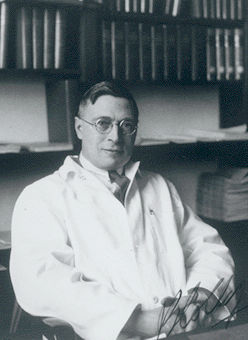Below is a list of five medical discoveries and innovations made by Canadians and Canadian research teams. By asking new questions, conducting experiments and publishing their findings, researchers throughout Canada have contributed towards the advancement of medical research, technology and knowledge. These developments have improved and saved the lives of individuals around the world.
Insulin
For many centuries people knew about diabetes mellitus (commonly referred to as diabetes), but it was only dimly understood until the end of the 19th century. Scientists believed that some kind of internal secretion of the pancreas was the key to preventing diabetes and controlling normal metabolism. No one could find it, until in the summer of 1921, when a team at the University of Toronto began trying a new experimental approach suggested by Sir Frederick Banting.
Between 1921 and 1922, Banting and Charles Best, under the direction of John James Rickard Macleod, isolated insulin in a lab at the University of Toronto. These pancreatic extracts were then purified and made safe for human injection by biochemist James Collip. By the spring of 1922, the Toronto researchers, were able to announce the discovery of insulin.
The discovery of insulin is one of the most important breakthroughs in modern medical history. Banting and Macleod were jointly awarded the Nobel Prize in Physiology or Medicine for this medical discovery (see Nobel Prizes and Canada).
Atlas of Congenital Cardiac Disease
The Atlas of Congenital Cardiac Disease was written by Maude Abbott. Abbott, who was initially was barred from studying medicine at McGill University because of her gender became curator of the McGill Medical Museum in 1901.
In 1931, Maude Abbott displayed artefacts from the McGill Medical Museum’s extensive collection as part of an exhibit for the New York Academy of Medicine. She brought the same exhibit to the Centenary Meeting of the British Medical Association in London in 1932. She was encouraged to compile her research into an atlas.
Abbott’s Atlas of Congenital Cardiac Disease was published by the American Heart Association in 1936. The Atlas was a groundbreaking text in cardiac research and it proved to be a life-saving resource. The publication helped doctors better understand and diagnose heart defects and develop new ways to treat them.
Cardiac Pacemaker

While studying hypothermia, Dr. Wilfred Bigelow and Dr. John Carter Callaghan were looking for ways to stimulate the heart. The team sought the help of Dr. John Hopps of the National Research Council of Canada. Dr. Hopps designed a portable artificial external cardiac pacemaker. This device sent electric pulses to the heart, which caused the heart to contract and pump. Hopps’ pacemaker was successfully tested by Dr. Wilfred Bigelow and Dr. John Carter Callaghan in 1950.
The portable artificial external cardiac pacemaker helped advance the development and use of implantable cardiac pacemakers in humans.
Polio Vaccine
During the first half of the 20th century, poliomyelitis, a.k.a. polio or “The Crippler,” hit Canada harder than anywhere else. Successive polio epidemics peaked in a national crisis in 1953. The public health, medical and research communities worked very hard to understand polio and how it could be prevented.
Canadian scientists played an important role in the development and production of the polio vaccine (see Canada and the Development of the Polio Vaccine). During the late 1940s, scientists at Connaught Medical Research Laboratories of the University of Toronto developed “Medium 199” while studying cancer cell nutrition. It was the world’s first purely synthetic nutrient medium for growing cells. Medium 199 was used to grow the poliovirus, providing a synthetic virus cultivation medium suitable for a human vaccine. University of Pittsburgh virologist Jonas Salk requested a supply of Medium 199, with which he prepared an inactivated poliovirus vaccine (IPV) that could be safely tested.
The team at Connaught also helped produce the polio vaccine on a large scale. Leone Farrell devised the “Toronto Method” in 1952–53. It involved growing the poliovirus in fluid cultures using large bottles gently rocked on custom-built rocking machines.
Following trials, the polio vaccine was licensed for use in the US and Canada. Research and development of the polio vaccine has reduced global polio incidence from 300,000 cases in 1988 to less than 40 today.
Cystic Fibrosis
Cystic fibrosis is an autosomal recessive disease. To date there is no cure for cystic fibrosis, but researcher teams have been working to better understand and treat the disease. In 1989, geneticist Lap-Chee Tsui and his collaborators from the Hospital for Sick Children at Toronto, and Francis Collins from the University of Michigan Medical School announced that they successfully isolated the gene carrying the defect that causes cystic fibrosis. The accomplishment has been called one of the most significant in the history of human genetics. In 1990 Tsui, Riordan and Collins were awarded the Canada Gairdner International Award for their research.

 Share on Facebook
Share on Facebook Share on X
Share on X Share by Email
Share by Email Share on Google Classroom
Share on Google Classroom











